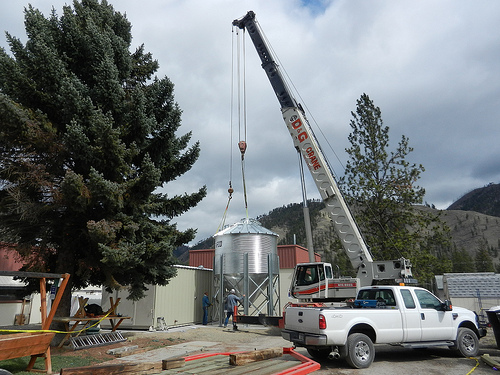As the drought continues today, USDA and other Federal agencies are doing all we can to help farmers, ranchers and communities who have been impacted.
Unfortunately, our tools are limited. Due to inaction by Congress, many parts of the 2008 Farm Bill expired October 1, and other aspects of the law will expire in the coming months.
This brings tremendous uncertainty for rural families – particularly livestock producers who have lost access to disaster programs, and dairy producers who no longer have access to dairy support programs.
The lack of a Food, Farm and Jobs Bill also limits USDA from continuing our record investments in homegrown American energy. Since 2009 USDA has worked hard to ensure that rural America plays a key role in our nation’s energy strategy. Read more »
USDA Rural Development Michigan State Director James Turner joined Senator Debbie Stabenow and local officials this summer in celebrating the opening of the largest commercial-scale anaerobic digester in the United States.
The Fremont Community Digester is an ambitious new use of a proven technology. Once used chiefly in farms, anaerobic digesters are now coming into their own.
The facility will convert organic waste products – such as farm and food waste – and process it into biogas. Approximately 1,500 local families will derive their power from this previously untapped energy source. Read more »

Work in progress on the Mineral Hospital Biomass Generator in Superior, Montana. Photo provided by Mineral Community Hospital
Mineral Community Hospital in Superior, Montana received an $190,000 Woody Biomass Utilization Grant from the U.S. Forest Service. The new Mineral Hospital Biomass Generator will use woody material such as beetle-killed trees removed from forests to help prevent wildfires. The material will then be processed in bioenergy facilities to produce green energy for heating and electricity. Read more »

This solar electric system, funded in part through USDA’s Rural Energy for America Program has reduced a Puerto Rican Paint company’s electric bill from $180,000/year to zero.
On September 13, Master Paints & Chemical Corporation located in the Municipality of Guayanila, Puerto Rico realized their goal when they became independent of the use of fossil fuel sources energy.
Master Paint & Chemical Corp is a local rural paint manufacturer that employs 260 people. This company represents one of the main jobs sources in the municipality. In the past, the cost of electricity totaled more than $180,000 annually. Energy savings in this area became a priority to grantee. With the installation of this system, the company will save 100 percent in yearly energy costs. Read more »

A portion of the 1,288 solar panels on 1.5 acres, which are connected to a 250 kW inverter to produce an estimated 600,000 kW hours of alternating current each year at the Forest Service’s San Dimas Technology Development Center. (Recsolar photo)
About 25 miles east of Los Angeles, the Forest Service’s San Dimas Technology Development Center is ready to start operations using a photovoltaic array to supply the buildings there with a potential 600,000 kilowatt hours of current each year.
“This system has made the San Dimas Center a ‘net-zero energy’ facility, the first in the U.S. Department of Agriculture,” explained Forest Service Chief, Tom Tidwell. “This means the facility produces more renewable energy per year than the total energy used by the facility.” Read more »

Local young people prepare the ground for tree plantings at the Urban Releaf ceremony in Oakland, Calif., on Aug. 20.
Urban forests are a vital part of our nation’s cities – they clean the air we breathe, capture pollution and stormwater and beautify our neighborhoods. Urban trees save cities millions of dollars in energy costs every year just from shade alone. U.S. Forest Service Chief Tom Tidwell has called urban trees “the hardest working trees in America.”
Tidwell underscored that statement during a recent visit Oakland, Calif. to view Urban Releaf’s greening and community-building efforts. He presented Kemba Shakur, executive director, a check for $181,000 to support education and demonstrations projects, as well as tree planting and maintenance throughout the Oakland area. Read more »




